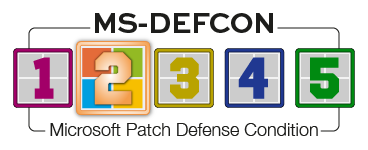By Susan Bradley
As usual, I recommend caution just before Microsoft’s Patch Tuesday and thus have raised the MS-DEFCON level to 2.
Let others (aka me) take the slings and arrows. There’s simply no way that those interested in headlines just as clickbait can assess the implications of any Patch Tuesday in just a few hours. I do some testing on my assorted PCs, follow other experts closely, separate fact from fiction, and aggregate what I learn into a Patch Watch column you can trust.
And so, relax and use your favorite method to forestall updates.
It’s eight months and counting until the end of support for Windows 10. Just the other day, I was asking someone in the office if they wanted me to get extended support updates for their home computer. The reply: “Oh, I don’t need support. I never call Microsoft.” Well, hardly anyone calls Microsoft, other than big corporations that can afford the long-term support contracts. The end of Win10 support doesn’t mean you will lose out on the ability to call Microsoft — it just means that your PC won’t get security updates.
Consumers may feel comfortable without such updates, especially if they are using a browser such as Firefox and using its updates to provide at least Web security. Firefox and other browsers will continue to be available for Windows 10 for some time, well past it’s official expiration.
However, business is a different matter — because of the need to follow regulations and guidelines specific to the line of business.
I’m in the process of investigating all available options we have for obtaining ESU updates. I’ve made preliminary contact with a volume-licensing vendor and will keep you posted.
Consumers
I hate “springing forward.” It’s not because I hate daylight saving time per se. I know it means more sunlight throughout the full active day. My problem is sleep deprivation. I know farmers follow the sunlight, but it means that we — and our computers — must adjust.
If the promised legislative end to daylight saving time occurs, it will result in updates to every supported operating system.
If you are my age, you will remember when daylight saving was paused to help with the energy crisis in December 1973. Mind you, I wasn’t using a computer back then. I just remember going to school when it was dark in the morning. In 1986, we started observing seven months of daylight saving and in 2007 we saw eight month’s worth. Each time there is a daylight saving adjustment, computers that automatically adjust the date and time must be updated with new rules. So if we do change again, Windows, all the Apple OSes, Android, and Linux will need updates.
Consumers may see preview updates in the form of Windows 10 KB5052077 and Windows 11 KB5052093. Both offer up a variety of nonsecurity changes and fixes. I do not recommend installing preview updates; instead, I review for highlights of things to come in the March security update.
Windows 10 will get a fix for an issue where Desktop Window Manager (dwm.exe) stops responding many times. Windows 11 preview includes a fix for an issue whereby apps might not recognize a scanner is available when it is connected.
Businesses
Speaking of clocks, if you also have a hybrid setup that bridges Active Directory with Entra ID, I recommend that you standardize on UTC time. If you have any sort of breach or investigation, it will help to have all on-premises logging and cloud logging using the same time zone.
I am still tracking issues related to OneDrive shared folder shortcuts showing up as Internet shortcuts. This is not related to a Windows update but appears to be some backend change that Microsoft has made. Disturbing, to say the least.
Also be aware that AutoCAD 2022 might not open after updating to Windows 11 24H2.
Let me kindly remind you that if you got pushed, shoved, or downright bullied to install 24H2, you have only 10 days to roll back to 23H2. To uninstall Windows 11 24H2 and go back to Windows 11 23H2, head to Settings and visit System | Recovery. Click on the Go back option and follow the on-screen instructions to revert and remove the 24H2 update from your PC. “Go back” may be grayed, which means you’re outside the 10-day grace period.
Plus member Simon Weel reports that he had several domain-based computers that were spontaneously updated to 24H2. I will be the first to tell you that I have never seen systems get updated if they have group policy settings to keep the feature release at a certain version, regardless of their being in a domain-based or peer environment. But I do know that the settings Microsoft uses to control updates via group policy have changed so many times over the years that it’s possible the group policy settings were not right. Microsoft respects group policy settings when it comes to updates. But it makes it increasingly hard to debug why a machine isn’t respecting the settings.
Hope you enjoyed this news post.
Thank you for appreciating my time and effort posting news every day for many years.
News posts... 2023: 5,800+ | 2024: 5,700+ | 2025 (till end of February): 874
RIP Matrix | Farewell my friend ![]()



3175x175(CURRENT).thumb.jpg.b05acc060982b36f5891ba728e6d953c.jpg)
Recommended Comments
There are no comments to display.
Join the conversation
You can post now and register later. If you have an account, sign in now to post with your account.
Note: Your post will require moderator approval before it will be visible.